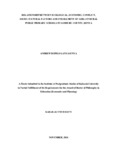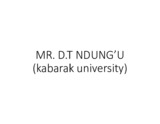| dc.description.abstract | This study sought to investigate the persistent low enrollment of girls in rural public primary schools in Samburu County, Kenya. In order to foster girls’ education, policies such as Education for All have been constituted. Kenya guarantees girls education through its Constitution and Basic Education Act, 2013. However, Samburu County, Kenya, still grapples with the problem of low enrollment of girls in its rural public primary schools. The objectives of this study therefore, were to establish the relationship between ecological, economic, inter-group conflict, and socio-cultural factors and enrollment of girls in rural public primary schools in Samburu County, Kenya. Descriptive correlation survey design guided by Social Conflict Theory by Oberschall (2015) was used. The target population was 136 female teachers and 135 head teachers who were male teachers from rural public primary schools in Samburu County. The sample was 136 female teachers selected through census method and 27 head teachers selected purposive method. However, 14 female teachers and 3 head teachers were used for piloting. Data was collected by use of questionnaires for female teachers and interview schedules for head teachers and analysed using Pearson Correlation and ANOVA. Test of hypothesis one (H01), on connection between ecological factors and the enrollment of girls in Samburu County revealed statistically significant negative Pearson Correlation Coefficient of -0.429 with a p-value (Sig.) of 0.025. The significance level at 5% indicates that higher ecological factors are associated with a decrease in girls’ enrollment. Second test (H02) on economic factors, yielded a significant negative correlation coefficient of -0.348, and the low p-value (Sig.) of 0.005 signifying significance at the 5% level. Test of H03 revealed a significant negative correlation of -0.537, with a low p-value (Sig.) of 0.005 signifying that higher levels of inter-group conflict factors went with reduction in girls’ enrollment. Pearson Correlation for H04 of Socio-cultural factors yielded a value of -.503 with 0.004 significance level, indicating moderate correlation. All the null hypotheses were rejected. Inter-group conflict rated higher, followed by socio-cultural factors as associated more with girl’s enrollment. Thus is explained by fear of attack when going to school, loss of livelihood source, and loss of human life, nomadic mobility, cultural practices, and perception about girl child. The study recommends a holistic approach to enhance girls’ education where educational stakeholders raise awareness on the importance of girls’ education, tackle negative traditional beliefs, increasing presence of female teachers, address economic .barriers, improve rural infrastructure, and tackle armed conflicts. | en_US |


